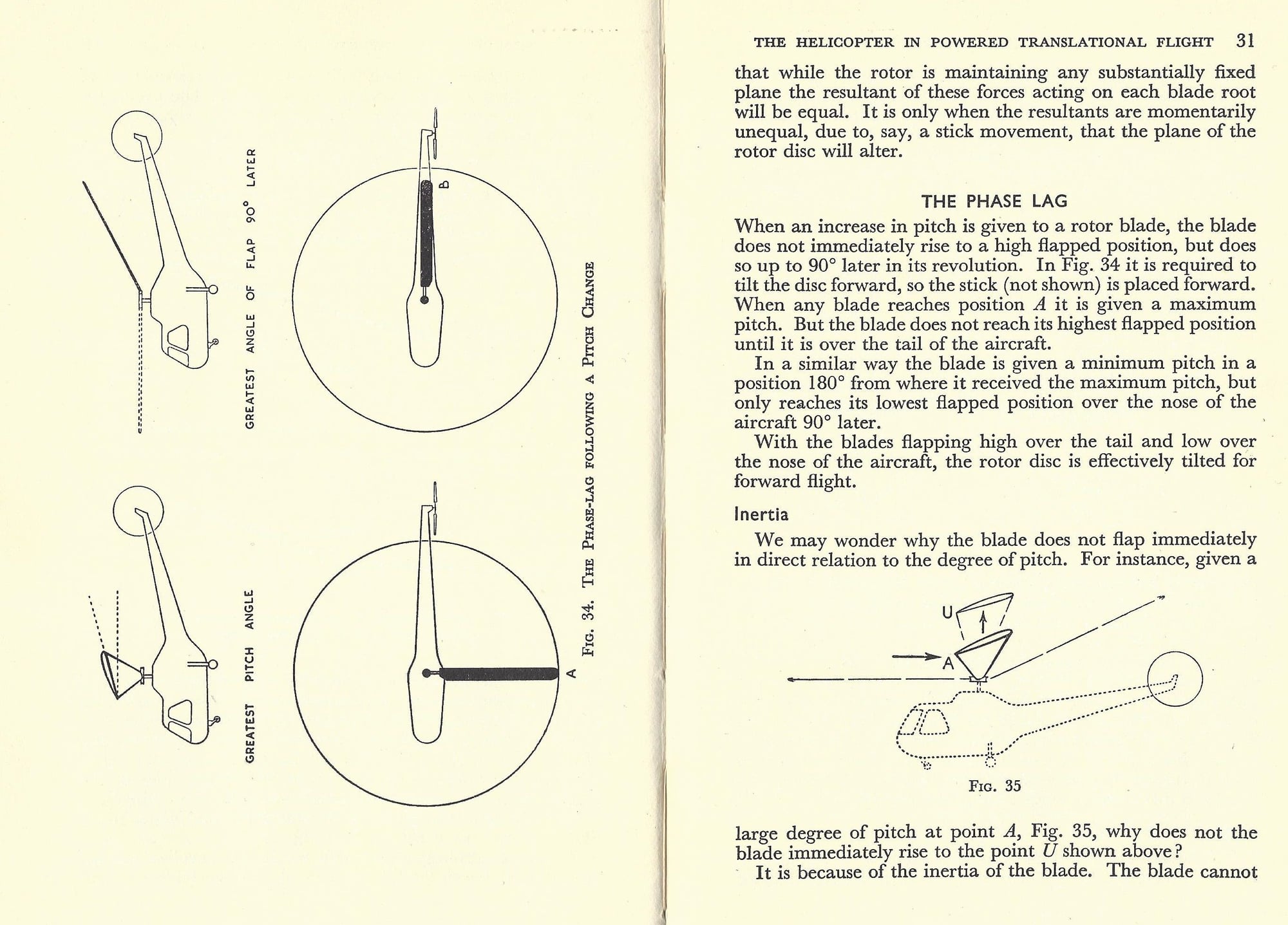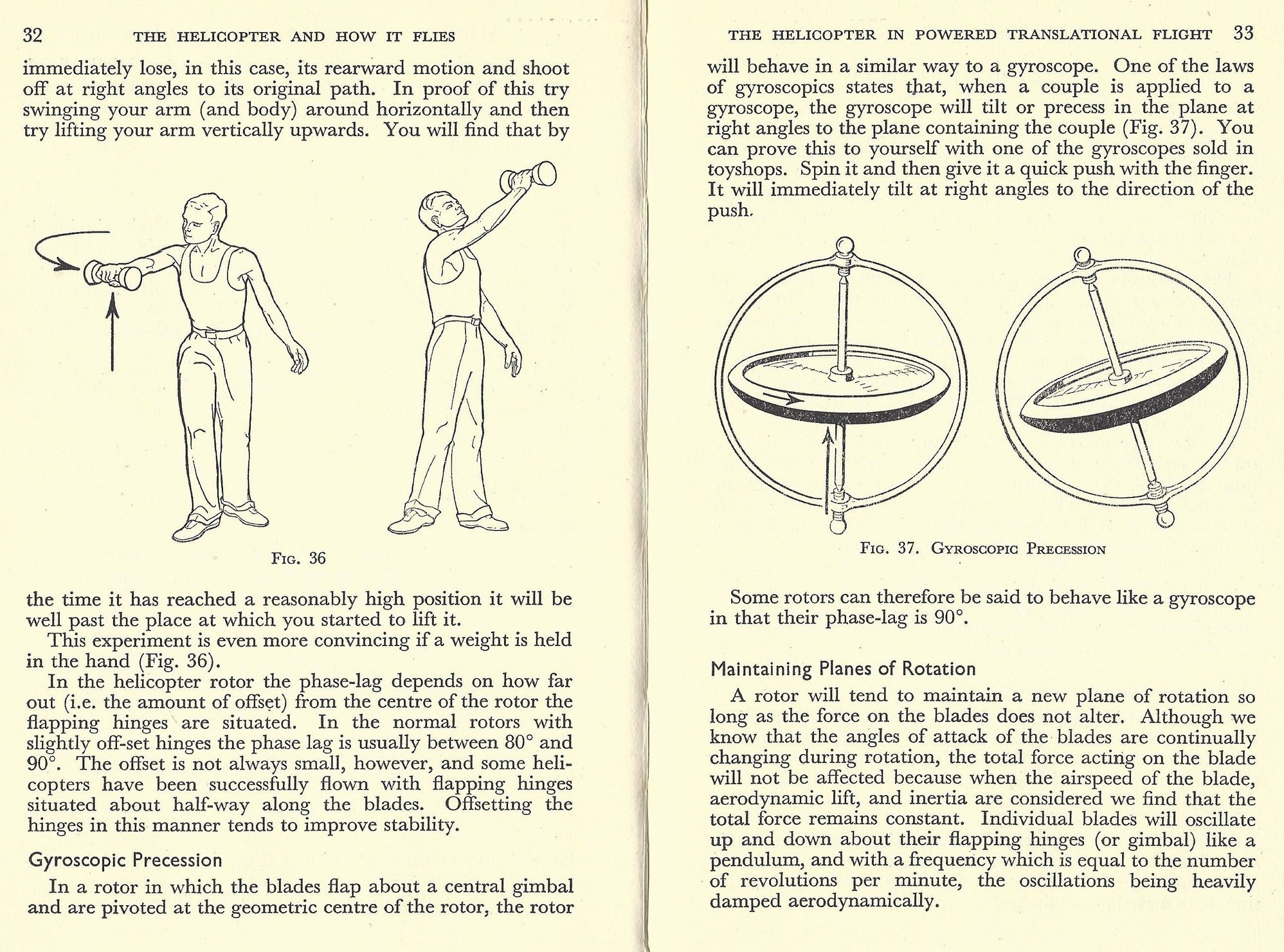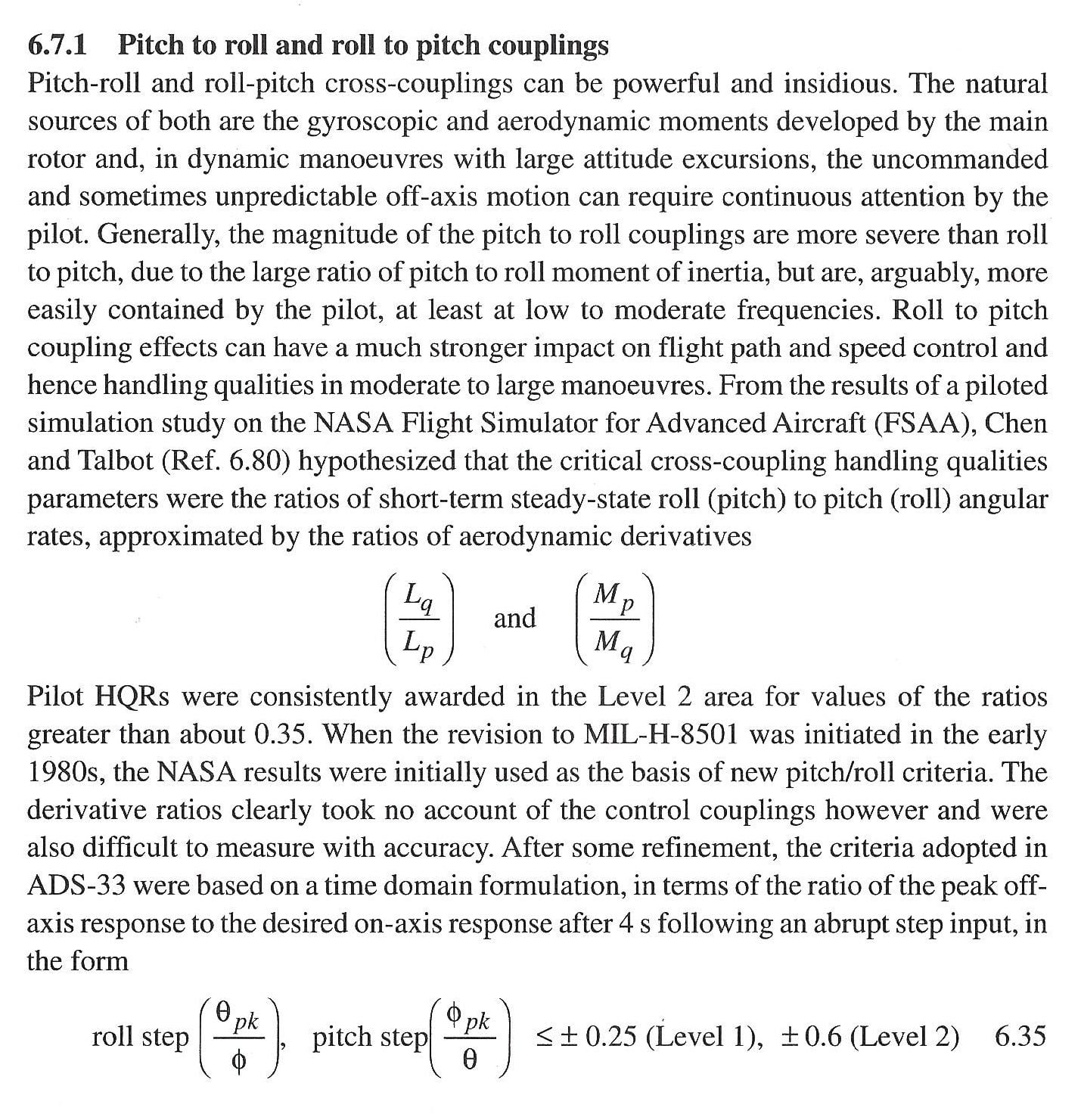Gyroscopic precession engineering question
Inertia vs aerodynamic damping

So according to Ray Prouty, Lu Zuckerman was wrong - it was 73 degrees not 72 degrees on the R22 rotor head

Teaching effects of controls on different helicopters with ASE/SAS/STAB off, you can see a nose pitching tendency when rolling into turns - it tends to go up one way and down the other depending on which way your rotors are turning.
I thought some of you might be interested to see how John S Fay described rotor phase lag in his 1954 book "The Helicopter and how it flies". He then goes on to indicate that "some rotors can therefore be said to behave like a gyroscope in that their phase lag is 90-degrees". So that association has been around a long time. Relevant pages as follows:




The following users liked this post:
And most people will see that he says that the 'rotor will behave in a SIMILAR way to a gyroscope', not like a gyroscope just in a similar way - he doesn't say it precesses like a gyro does - perhaps it is in English comprehension that the message is lost.
I once came across the textbook "Helicopter Flight Dynamics" by Gareth D. Padfield (1996) and bought it thinking it would be an interesting read. But it really was much too heavy for me! None the less, hope Gareth doesn't mind me sharing a pair of extracts from the book, one on "The fundamental 90 deg phase shift" (page 36) and the other on "pitch to roll and roll to pitch couplings" (page 417). Some light bed time reading:
Page 36 extract:

Page 417 extract:

Page 36 extract:

Page 417 extract:

Join Date: Nov 2000
Location: White Waltham, Prestwick & Calgary
Age: 72
Posts: 4,151
Likes: 0
Received 29 Likes
on
14 Posts
Don't let EASA see that - the silly beggars will turn it into a question 
Bell once used blades on a Bell 206 that were double the normal weight and they ended up with a gamma of 180°! In fact, the blades had so much energy that there was also no H/V curve.

Bell once used blades on a Bell 206 that were double the normal weight and they ended up with a gamma of 180°! In fact, the blades had so much energy that there was also no H/V curve.
The following users liked this post:
I thought some of you might be interested to see how John S Fay described rotor phase lag in his 1954 book "The Helicopter and how it flies". He then goes on to indicate that "some rotors can therefore be said to behave like a gyroscope in that their phase lag is 90-degrees". So that association has been around a long time. Relevant pages as follows:
FWIW, I believe the reference is to the Bell-Hiller rotor system, although not explicitly stated.
The following users liked this post:
https://apps.dtic.mil/sti/tr/pdf/ADA071648.pdf
The report titled "Flight Test Evaluation of the High Inertia Rotor System" was produced by Bell Helicopter Textron in June 1979. The tests used a modified prototype OH-58A and evaluated three different rotor inertias with the lowest being similar to the rotors of the standard OH-58A and the highest being more than double that inertia. Blades were not necessarily double the standard weight, rather the high inertia was achieved by adding more tip masses to the modified rotor system. Page 40 shows the H-V curve for the standard and three different inertias. No limit curve for the highest inertia as you said. Page 96 reports a case of apparent entry into VRS for one of the test points with the helicopter contacting the ground but then becoming airborne again due to the available inertia! Page 97 discusses the more sluggish response of the higher inertia rotor, but addressed by incorporating a "control quickener".
For the record i'm in team flapping!
But the AI accurately represents the position of the horizon demonstrating rigidity in space.
The helicopter wheels may be lashed to the deck but the disc is free to flap, only limited by the pilot's vice-like grip on the cyclic.
The helicopter wheels may be lashed to the deck but the disc is free to flap, only limited by the pilot's vice-like grip on the cyclic.
The rotor coupling response suggests behavior more like a rate gyro, at least in the machines I’ve been exposed to with reasonably broad maneuver envelopes. The S-67 was an interesting example. It did have the electronics from the CH-54B Skycrane installed, but flew so well without ( it did always have the stick force per G, Feel Augmentation System on ) that we never set up the gains and it remained N/A.
During the demo tours in the USA ( 1971 ) and UK/Germany/Iran/Greece ( 1972 ) probably 2-300 pilots got to fly it, and the standard flight included a split S and a roll: one each by the SA pilot flying with the guest pilot on the controls and one each by the guest pilot with the SA pilot helping as needed*. Roll Procedure was simple: put the nose down 10-15 degrees ( any angle ok-just hold that pitch attitude, then set collective around 70%Q ( anything around that was fine ) when you got to around 170KIAS pull the nose up to around +15 degrees-again, anything around that was OK, and when the speed dropped to around 130-140 or whatever, put the cyclic on the right stop**, and watch the world go around. No need to move anything until the world was level again. Roll took about 4 seconds plus a bit and the aircraft would, without any longitudinal correction, come out about level. So, with that 12 inch flapping offset main rotor, the coupling was absolutely there, but easily manageable.
*One of the gust pilots in Germany was former Luftwaffe Chief of Fighters Adolf Galland. He needed no help doing anything.There was one UK Spitfire WWII pilot of high rank and multiple decorations whose name escapes me now, but who walked very unsteadily with a cane up to the 67, and needed help from two people getting into the 67 front seat, but once there, like General Galland, needed no help in maneuvering the 67..
**And yes, we did rolls to the right only, but not for any aerodynamic or dynamic coupling reasons but because in left rolling maneuvers the tail rotor edgewise stresses were high enough so that we would have to cycle count the maneuvers if we went the other way ( tail rotors had a flapping hinge but did not incorporate a drag hinge ).
This post is a bit off subject but indicative that the coupling induced higher rate maneuvers are handled naturally by the pilots.
During the demo tours in the USA ( 1971 ) and UK/Germany/Iran/Greece ( 1972 ) probably 2-300 pilots got to fly it, and the standard flight included a split S and a roll: one each by the SA pilot flying with the guest pilot on the controls and one each by the guest pilot with the SA pilot helping as needed*. Roll Procedure was simple: put the nose down 10-15 degrees ( any angle ok-just hold that pitch attitude, then set collective around 70%Q ( anything around that was fine ) when you got to around 170KIAS pull the nose up to around +15 degrees-again, anything around that was OK, and when the speed dropped to around 130-140 or whatever, put the cyclic on the right stop**, and watch the world go around. No need to move anything until the world was level again. Roll took about 4 seconds plus a bit and the aircraft would, without any longitudinal correction, come out about level. So, with that 12 inch flapping offset main rotor, the coupling was absolutely there, but easily manageable.
*One of the gust pilots in Germany was former Luftwaffe Chief of Fighters Adolf Galland. He needed no help doing anything.There was one UK Spitfire WWII pilot of high rank and multiple decorations whose name escapes me now, but who walked very unsteadily with a cane up to the 67, and needed help from two people getting into the 67 front seat, but once there, like General Galland, needed no help in maneuvering the 67..
**And yes, we did rolls to the right only, but not for any aerodynamic or dynamic coupling reasons but because in left rolling maneuvers the tail rotor edgewise stresses were high enough so that we would have to cycle count the maneuvers if we went the other way ( tail rotors had a flapping hinge but did not incorporate a drag hinge ).
This post is a bit off subject but indicative that the coupling induced higher rate maneuvers are handled naturally by the pilots.
The following users liked this post:
,...but I'm team teeter.

So this has been a useful debate.
We seem to agree that the rotor does not demonstrate one key feature of a gyroscope, namely rigidity in space. The question I think we're now trying to answer is whether the control lag for a helicopter rotor is 'like a gyro', ie. governed by the same kinematics as a gyro, or 'like a gyro' in the sense that it has similar observable characteristics but no connection to the kinematics of a gyro.
And then when we've answered that we can debate whether the gyro simile is an appropriate teaching tool for helicopter pilots. I would say that if the former prevails, then there's a qualified case for it. If the latter, then probably not.
We seem to agree that the rotor does not demonstrate one key feature of a gyroscope, namely rigidity in space. The question I think we're now trying to answer is whether the control lag for a helicopter rotor is 'like a gyro', ie. governed by the same kinematics as a gyro, or 'like a gyro' in the sense that it has similar observable characteristics but no connection to the kinematics of a gyro.
And then when we've answered that we can debate whether the gyro simile is an appropriate teaching tool for helicopter pilots. I would say that if the former prevails, then there's a qualified case for it. If the latter, then probably not.
I think the former is demonstrably wrong and the latter is only true of teetering rotors.
Therefore using gyroscopes as a way to teach rotor behaviour simply ignores the reality of basic aerodynamics - why would you do that?
If you want to be a pilot, learn some aerodynamics - if you want to be a physicist, learn gyroscopes.
Some of the advanced texts quoted here show that in SOME rotors, it is possible to explain cross-coupling effects using gyroscope tendencies but those aren't for PPL, CPL or even possibly ATPL study.
Dumbing down training to make it 'easier' is a great way to cause more accidents through ignorance.
Therefore using gyroscopes as a way to teach rotor behaviour simply ignores the reality of basic aerodynamics - why would you do that?
If you want to be a pilot, learn some aerodynamics - if you want to be a physicist, learn gyroscopes.
Some of the advanced texts quoted here show that in SOME rotors, it is possible to explain cross-coupling effects using gyroscope tendencies but those aren't for PPL, CPL or even possibly ATPL study.
Dumbing down training to make it 'easier' is a great way to cause more accidents through ignorance.
Join Date: Nov 2000
Location: White Waltham, Prestwick & Calgary
Age: 72
Posts: 4,151
Likes: 0
Received 29 Likes
on
14 Posts
"Dumbing down training to make it 'easier' is a great way to cause more accidents through ignorance."
If you want proof, just look at the EASA questions.
If you want proof, just look at the EASA questions.
Originally Posted by [email protected]
If you want to be a pilot, learn some aerodynamics - if you want to be a physicist, learn gyroscopes.
A pilot needs skills, not theory. Theory is required to let the person understand and train a certain required skillset, but it is what it is: background foundation. Otherwise Usain Bolt would be an expert in body dynamics. Or the Euler equations would be written down on every pilot kneeboard.
You might feel "better prepared" because your "theory" is of another level. The same applies to you unfortunately. There is a limit to what you know and apply. At the end of the day what the "theoretical" pilot needs to realise is that his "aerodynamics" is nothing more than fluidodynamics with a tuned down vision on compressibility (we consider it incompressible for a lot of our thinking). Once we enter that zone things get quickly rough for many pilots, especially when discussing rotor dynamics.
Keep it simple, that keeps it safe.
That is only valid up to a certain point, and reality has shown it has an equally dramatic downside: the overthinking pilot. He crashes quicker than anybody else.
It flies in the face of what I have experienced in 42 years of flying.
Underthinking pilots who underprepare because they think simply learning to control the machine in a straight line makes them good pilots.
Originally Posted by [email protected]
got any evidence to back that assertion up?
It flies in the face of what I have experienced in 42 years of flying.
Underthinking pilots who underprepare because they think simply learning to control the machine in a straight line makes them good pilots.
It flies in the face of what I have experienced in 42 years of flying.
Underthinking pilots who underprepare because they think simply learning to control the machine in a straight line makes them good pilots.
The thinker is always late, he is one of the most difficult people to train as his natural problem handling process is to think about it when he's supposed to act. Understanding is not a problem solution. You still die if you understand the reason why you're dying and the acting came to late. Overemphasising technical knowledge creeps into the ego of many people, and claims an idea that "they know". They usually don't, as even the most advanced theoretical pilot training is limited and does not tell full stories.
Ask any old pilot to explain the theory behind his flying, he will not be able. It doesn't matter to know the why. It matters to know how to act appropriatly.
Keep it simple saves lifes. Complicated theory wastes time.
The following users liked this post:



